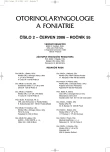Inverted Papilloma of the Nose and Paranasal Sinuses Part 2 - Analysis of the Cohort
Authors:
P. Matoušek; Pavel Komínek
Authors‘ workplace:
ORL oddělení Nemocnice ve Frýdku-Místku
primář MUDr. P. Komínek, Ph. D.
Published in:
Otorinolaryngol Foniatr, 55, 2006, No. 2, pp. 79-83.
Category:
Original Article
Overview
Objective:
A comparison of the incidence of relapses after external and endoscopic interventions for inverted papilloma of the nose and paranasal sinuses
Type of study:
A retrospective study.
Materials and Methods:
The authors made a retrospective analysis of the group of patients having been treated for inverted papilloma of the nose and paranasal sinuses. In 1994 – 2004 twelve patients were treated by surgery. Men (n=8) were more frequent than women (n=4).A thirty years old woman was the youngest patient, whereas a 69-year man was the oldest one. No side predilection was noticed (5 cases on the left and 5 cases on the right), and bilateral localization was observed in two cases. Fourteen sides were surgically treated on the whole. The endoscopic approach was selected nine times, the external one five times – medial maxillectomy prevailed with the access via lateral rhinotomy (4 times), the midfacial degloving was performed once.
Results:
The postoperative observation was 57 months on the average (median 58 months) and the shortest period of observation was seven months, the longest one for 120 months. The relapses were observed in four cases after endoscopic intervention (4/9, i.e. 44%), in one case after the external intervention (1/5, i.e. 20%). The relapses were encountered in 35%, the longest one being after 33 months, 16.5 months on the average.
Conclusion:
The relatively high number of relapses clearly indicates that we should think about the suitability of endoscopic approach in solving IP. The retrospective analysis of the group of patients operated on at our ward make it clear that some principles to which the authors defending the endoscopic endonasal approach had drawn particular attention (radicality, the use of milling machine) were not observed. It has become apparent that when the endoscopic endonasal approach is used a greter radicality becomes necessary and the basic prerequisite is a sufficient view of the operation field. The high frequency of relapses after endoscopic solution of IP in our group does not necessarily mean that the indication schemes should be changed when the selection of external and endoscopic approaches are considered, but is an argument in favor of increased radicality of endoscopic approach.
Key words:
inverted papilloma, relapse, external and endoscopic approach.
Labels
Audiology Paediatric ENT ENT (Otorhinolaryngology)Article was published in
Otorhinolaryngology and Phoniatrics

2006 Issue 2
Most read in this issue
- Tonsicellectomy in the Cold and Warmth
- Nodular Cervical Metastases of Spinocellular Carcinoma of Oropharynx and Pharynx (Part 2)
- Mucosal Melanomas of the Head and Neck
- Surgical Treatment of Cholesteatoma
